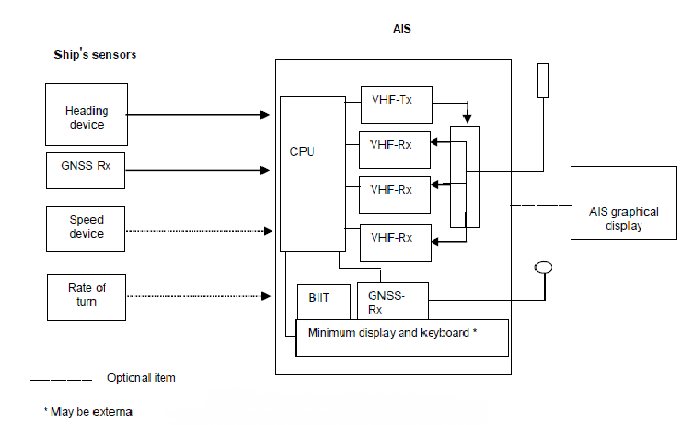COMPONENTS
1 In general, an onboard AIS (see figure 1)
consists of:
- - antennas;
- - one VHF transmitter;
- - two multi-channel VHF
receivers;
- - one channel 70 VHF receiver for
channel management;
- - a central processing unit
(CPU);
- - an electronic position-fixing
system, Global Navigation Satellite System (GNSS) receiver for timing
purposes and position redundancy;
- - interfaces to heading and speed
devices and to other shipborne sensors;
- - interfaces to radar/Automatic
Radar Plotting Aids (ARPA), Electronic Chart System/Electronic Chart Display
and Information System (ECS/ECDIS) and Integrated Navigation Systems
(INS);
- - built-in integrity test (BIIT);
and
- - minimum display and keyboard to
input and retrieve data.
With the integral minimum display and keyboard unit, the AIS would be
able to operate as a stand-alone system. A stand-alone graphical display or the
integration of the AIS data display into other devices such as INS, ECS/ECDIS or a
radar/ARPA display would significantly increase the effectiveness of AIS, when
achievable.
2 All onboard sensors must comply with the
relevant IMO standards concerning availability, accuracy, discrimination, integrity,
update rates, failure alarms, interfacing and type-testing.
3 AIS provides:
- - a BIIT running continuously or at
appropriate intervals;
- - monitoring of the availability of
data;
- - an error detection mechanism of the
transmitted data; and
- - an error check on the received
data.

Figure 1 - AIS Components
CONNECTIONS
The connection of AIS to external navigational display systems
4 The AIS can be connected either to an additional
dedicated AIS display unit, possibly one with a large graphic display, or as an
input to existing navigational system devices such as a radar display, ECS, ECDIS,
or INS. Such system interconnection and data integration is recommended."
The connection of AIS to external portable navigational equipment
5 It is becoming common practice for pilots to possess
their own portable navigational equipment, which they carry on board. Such devices
can be connected to shipborne AIS equipment and display the targets they receive.
Some Administrations require this connection to be provided at the bridge front.